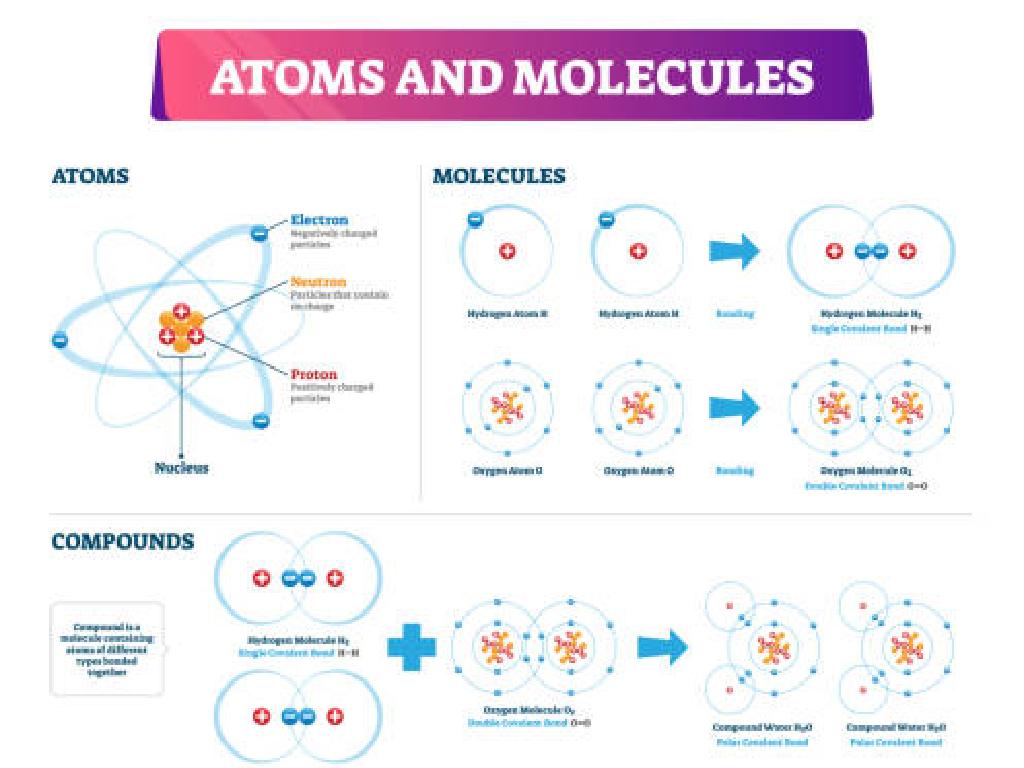Laboratory Safety Equipment
Subject: Science
Grade: Sixth grade
Topic: Science Practices And Tools
Please LOG IN to download the presentation. Access is available to registered users only.
View More Content
Welcome to Science Lab Safety
– Importance of lab safety
Safety prevents accidents and injuries.
– Key safety rules in the lab
Always follow instructions, wear safety gear, and report spills.
– Types of safety equipment
Learn about goggles, gloves, aprons, and fire extinguishers.
– Using equipment safely
We’ll discuss proper use and maintenance of safety equipment.
|
This slide introduces students to the fundamental concepts of laboratory safety, emphasizing the prevention of accidents and injuries. It’s crucial to instill the importance of following safety rules, such as wearing appropriate gear and reporting any spills or unsafe conditions immediately. Highlight the various types of safety equipment they will encounter, including protective goggles, gloves, aprons, and fire extinguishers. Explain that understanding how to use and maintain this equipment is key to a safe laboratory environment. Engage the students by asking them to think of safety scenarios and how they would apply these rules and equipment.
Personal Protective Equipment (PPE)
– Understanding PPE and its importance
– PPE helps protect you from hazards in the lab.
– Common PPE: Lab coat, goggles, gloves
– Lab coat shields clothes, goggles protect eyes, gloves guard hands.
– Proper usage of PPE
– Learn to wear PPE correctly to ensure maximum safety.
– Caring for your PPE
– Keep PPE clean and store it properly after use.
|
This slide introduces students to the concept of Personal Protective Equipment (PPE) and its critical role in laboratory safety. PPE is essential for protecting students from potential hazards when conducting experiments. Discuss the types of PPE commonly used in labs, such as lab coats, goggles, and gloves, and explain their specific protective functions. Emphasize the importance of using PPE correctly, which includes putting it on in the right order, ensuring a proper fit, and removing it without contaminating oneself. Teach students the proper maintenance of PPE, including cleaning and safe storage, to maintain its protective qualities. Encourage questions to ensure students understand how to use and take care of their PPE.
Safety Showers & Eye Wash Stations
– Locate safety showers & eye washes
– Usually found along lab walls, near exits.
– Instructions on using them
– Pull handle for shower, push lever for eye wash.
– Use during emergencies
– In case of chemical spills or splashes, use immediately.
– Importance for safety
|
This slide aims to educate students on the critical safety equipment available in the laboratory. Safety showers and eye wash stations are essential for immediate first aid in the event of a chemical spill or splash. It’s important to familiarize students with the location of these safety tools and the proper procedures for using them. Emphasize that in an emergency, quick action can prevent serious injuries. Conduct a lab walk-through to point out these stations and demonstrate their use. Reinforce the message that these tools are for emergency use only and not for regular cleaning or non-emergency situations.
Fire Safety Equipment in the Lab
– Types of fire safety tools
– Extinguishers and fire blankets are crucial.
– Using a fire extinguisher
– Pull the pin, aim low, squeeze handle, and sweep side to side.
– Matching fires to extinguishers
– Water, foam, CO2, and powder extinguishers for different fires.
– Fire safety best practices
– Always know your nearest exit and fire equipment location.
|
This slide introduces students to the essential fire safety equipment found in a laboratory setting, such as fire extinguishers and blankets. It’s important to demonstrate the correct usage of a fire extinguisher – remember the PASS technique: Pull, Aim, Squeeze, and Sweep. Discuss the various types of fires, such as electrical, grease, and chemical fires, and which type of extinguisher is appropriate for each. Emphasize the importance of knowing the location of fire safety tools and the nearest exit in case of an emergency. A class visit to the lab to identify these items or a demonstration by a local fire department could be very beneficial.
First Aid Kit: Safety First!
– Essential items in a first aid kit
– Bandages, antiseptics, gauze, and gloves
– Treating small cuts and bruises
– Clean the wound, apply ointment, and bandage
– Recognizing when to get more help
– If injury is severe, persistent, or if unsure
– Keeping a kit accessible at all times
|
This slide introduces students to the importance of a first aid kit in a laboratory setting. Discuss the various items typically found in a first aid kit, such as bandages, antiseptic wipes, sterile gauze, and gloves, and their uses. Explain the basic steps for treating minor injuries like small cuts or bruises: cleaning the wound, applying antiseptic ointment, and covering with a bandage. Emphasize the importance of knowing when an injury requires additional medical attention, such as when it’s severe, doesn’t stop bleeding, or if there’s any doubt about the severity. Lastly, stress the importance of having a first aid kit readily available and known to all students in the lab for quick response to any accidents.
Chemical Spill Safety in the Lab
– Essential items in a spill kit
– Include gloves, goggles, absorbent materials, and neutralizing agents.
– Steps for handling chemical spills
– Alert others, don protective gear, contain the spill, dispose of waste safely.
– Safe practices for chemical use
– Always read labels, follow instructions, and never mix chemicals without guidance.
|
This slide aims to educate students on the importance of being prepared for chemical spills in the laboratory by understanding the components of a chemical spill kit and the steps to take in case of a spill. Emphasize the significance of safety equipment like gloves and goggles and the use of absorbents and neutralizers to manage spills. Teach students the correct procedure to follow in the event of a spill: alerting others, wearing protective gear, containing the spill, and disposing of waste properly. Additionally, instill in them the habit of safe chemical handling by reading labels, following instructions, and using caution when dealing with chemicals. This knowledge is crucial for maintaining a safe learning environment in the science lab.
Understanding the Fume Hood
– What is a fume hood?
– A ventilated enclosure in a chemistry lab, used to safely work with volatile substances.
– Proper use of a fume hood
– Always keep sash at recommended level, work 6 inches inside, and check airflow before use.
– Maintaining safe air quality
– Regular checks ensure harmful vapors are properly vented, maintaining a safe breathing environment.
– Importance in lab safety
– Fume hoods prevent inhalation of toxic fumes, protecting students during experiments.
|
A fume hood is a critical piece of safety equipment in a laboratory, designed to limit exposure to hazardous or toxic fumes, vapors, or dust. It’s essential for students to understand how to use it properly, including adjusting the sash to the correct height, working at the appropriate distance inside the hood, and verifying that the airflow is functioning before beginning any work. Emphasize the role of the fume hood in maintaining air quality and protecting their health. Discuss the consequences of improper use and the importance of regular maintenance. Provide examples of experiments that would require a fume hood and encourage students to always be mindful of safety protocols.
Emergency Procedures in the Lab
– Know your emergency exits
– Locate and remember the quickest route out.
– Practice lab safety drills
– Regular drills help remember steps in an emergency.
– Responding to accidents
– Stay calm, inform a teacher, and follow instructions.
– Importance of preparedness
|
This slide aims to educate students on the critical aspects of emergency procedures in a laboratory setting. It’s essential for students to be aware of the nearest emergency exits and evacuation routes to ensure a quick and orderly escape in case of an emergency. Emphasize the importance of participating in lab safety drills, which are practical exercises to prepare students for real-life emergencies. In the event of an accident, students should know the immediate steps to take, including remaining calm, quickly informing a teacher, and following the provided safety instructions. Highlight the overall importance of being prepared for any situation to ensure the safety and well-being of everyone in the lab.
Class Activity: Safety Scavenger Hunt
– Identify lab safety equipment
– Demonstrate equipment usage
– Show how to properly use one item, like goggles or a fire extinguisher
– Discuss equipment’s importance
– Why is this equipment crucial for our protection?
– Engage with peers on safety
|
This interactive class activity is designed to familiarize students with the various pieces of safety equipment available in the laboratory. Students will work in small groups to locate and identify different safety tools, such as goggles, gloves, fire extinguishers, and emergency showers. They will then select one piece of equipment and demonstrate its correct usage to the class, explaining the procedures and safety measures associated with it. Following the demonstrations, students will engage in a group discussion about the importance of each piece of equipment and share personal insights or experiences related to lab safety. The teacher should circulate to provide guidance, ensure correct usage is demonstrated, and facilitate discussions. Possible variations of the activity could include creating safety posters, role-playing different safety scenarios, or developing a lab safety guide as a class project.






